|
Week 3: August 15-21, 2012 |
Welcome
to the McGill Bird Observatory weekly report.
Click here for a complete listing of our archives.
Comments or
questions are welcome at "mbo AT migrationresearch.org".
|
PICTURE
OF THE WEEK: |
|
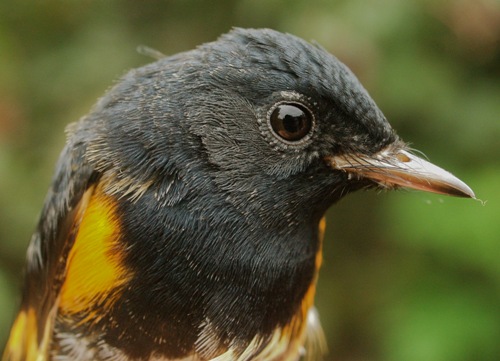
American Redstarts are migrating through MBO in good numbers again, with 81
banded already this fall, trailing only Song Sparrows in abundance.
(Photo by Simon Duval)
-
|
|
|
THIS WEEK |
THIS FALL |
2012 TOTAL |
SITE TOTAL |
|
# birds (and species) banded |
161 (41) |
685 (53) |
1950 (78) |
37701 (108) |
|
# birds (and species) repeat |
61 (18) |
185 (27) |
523 (43) |
6936 (69) |
|
# birds (and species) return |
9 (7) |
29 (16) |
168 (25) |
1129 (38) |
|
# species observed |
85 |
102 |
155 |
207 |
|
# net hours |
540.0 |
1652.0 |
4911.8 |
64010.9 |
|
# birds banded / 100 net hours |
29.8 |
41.5 |
39.7 |
58.9 |
|
|
Note: table does not include nocturnal banding (owls) |
|
Banders-in-charge: Simon Duval, Gay Gruner
Assistants: Christine Barrie, Suzanne Bérard, Nicolas Bernier, Sue Bishop, Jean Demers, Rui de Jesus, Tammy Elliot, Louise Gagné, Nathalie Gendron, Tiffany Gilchrist, Alison Hackney, Lima Kayello, Lisa Keelty, Shelley Kirk, Barbara MacDuff, Ana Morales, Tash Nicholson, Yves Payette, Benoit & Francine Piquette, Lisa Rosenberger, Ahmad Shah, Clémence Soulard, Carine Touma, Monique Venne
Notes: Week 3 is traditionally the slowest part of the fall season at MBO, and sure enough, the volume of migration tapered off after the record-setting opening two weeks of this fall. However, looking at the season on the whole, the 685 birds banded to date are just behind 692 at this time in 2010, and the 53 species banded so far is a record high after the first three weeks of fall. Success in the nets is continuing to be mirrored by a great diversity of observations, with 85 species observed this week (a record high for week 3), and 102 species so far this season, the first time the century mark has been reached this quickly.
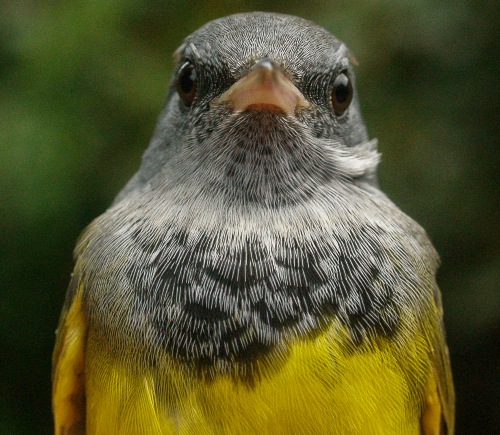
Mourning Warblers are one of the less common warblers at MBO, with a range of only 6-14 banded per fall season.
(Photo by
Simon Duval) |
The highlight this week was MBO's second sighting of Blue-gray Gnatcatcher, the first coming near the end of the 2008 spring migration monitoring program. This week's sighting was in the sumacs just past the C nets, leading us to hope we might also be able to band this one, but it was not to be, and it appears to not have lingered in the area. Also seen for the first time this year were Great Egret, Bald Eagle, and Olive-sided Flycatcher. Others recorded for the first time this fall were Least Flycatcher and a quintet of warblers: Black-throated Green, Bay-breasted, Blackburnian, Blackpoll, and Wilson's. On the banding side, we added 8 more species for fall, although all had been banded previously in spring: Least Flycatcher, Blue Jay, Bay-breasted Warbler, Cape May Warbler, Blackpoll Warbler, Wilson's Warbler, Common Grackle, and American Goldfinch. We also had our first Tennessee Warbler and American Redstart returns of the year. One of this week's two Tennessee Warbler returns was banded on August 24, 2011, and recaptured this week on August 21 - in the same net! The American Redstart return this week was banded on August 14, 2011 as a hatch-year female, and recapped almost exactly one year later (August 16). We also had a return visit from an older Red-eyed Vireo, banded on August 12, 2008, last recaptured on August 4, 2009, and back for another visit this week on August 17.
This week’s top 10 [last week's rank in brackets]
# individuals banded |
mean # individuals observed daily |
1. Common Yellowthroat (21) [5] |
1. Common Grackle (186) [1] |
2. American Redstart (19) [1] |
2. Canada Goose (46) [8] |
3. Song Sparrow (14) [2] |
3. Cedar Waxwing (26) [3] |
4. Magnolia Warbler (12) [-] |
4. American Goldfinch (22) [2] |
5. Red-eyed Vireo (8) [7] |
5. American Robin (21) [7] |
6. Northern Waterthrush (6) [-] |
6. American Crow (17) [6] |
6. Mourning Warbler (6) [-] |
7. Black-capped Chickadee (17) [5] |
8. Swainson's Thrush (5) [7] |
8. Song Sparrow (13) [4] |
8. Tennessee Warbler (5) [-] |
9. Blue Jay (10) [-] |
10. Black-capped Chickadee (4) [-]
10. Veery (4) [-]
10. Gray Catbird (4) [10]
10. Ovenbird (4) [-]
|
10. Baltimore Oriole (8) [10] |
|
Although the number of birds banded dropped from last week, there were enough to show a distinct change in the composition of migrants coming through. Three of last week's top five species (Traill's Flycatcher, Baltimore Oriole, and Cedar Waxwing) dropped right out of the top ten this week, and thanks to a four-way tie for tenth place, there were seven new additions to the list this week, including four warblers. Coming out on top, for the first time ever, was Common Yellowthroat with 21 individuals banded, more than ever before in a single week in August. Close behind was the week 3 champion for four of the past five years, American Redstart ... followed by Song Sparrow, which took top spot in week 3 in the other three previous seasons. Magnolia Warbler numbers are starting to build, in anticipation of them coming out on top in week 4 (as has been the case in every year to date except 2009). Red-eyed Vireos continue to be a steady presence this August. New warbler entries this week also included Northern Waterthrush, Mourning Warbler (with 6 individuals this week tying the full fall season count in 2006, and just one behind the 2011 total), Tennessee Warbler, and Ovenbird. We had another 5 moulting Swainson's Thrushes this week, bringing our total for the season to an impressive 17 already (in comparison we banded a grand total of 9 Swainson's Thrushes over the first three weeks of the season in our first five fall programs combined!).
Compared to the turnover on the list of birds banded, the dominant species observed this week changed much less. Common Grackle stayed on top for a second week in a row, with over 100 counted each day of the week but one, and a peak count of 530 on August 18. This is the first time Common Grackle has dominated week 3. Canada Goose numbers seem to be building unusually early this year, rising to second place despite never before having placed in the top ten in week 3. In contrast, Cedar Waxwing is a model of consistency, staying in third place every week so far this season, and also having been in the top five at this time of year three times previously. Even more reliable in the long term, American Goldfinch has always been between second and sixth place in week 3, and is right in the middle of that range this year. The next several places fall to several of our local regulars - American Robin, American Crow, Black-capped Chickadee, and Song Sparrow. Blue Jay numbers built up for the first time this fall, bumping European Starling off from last week's list, while Baltimore Oriole rounded out last place for a second straight week, but will likely soon be moving on to the south.
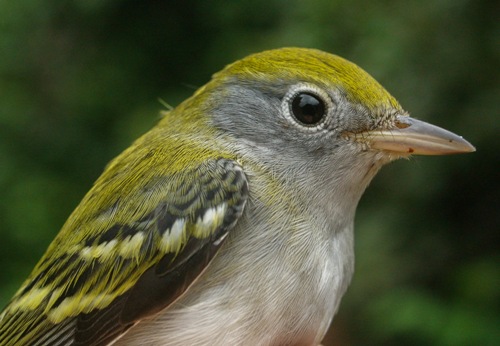
Although lacking its namesake streaks, this Chestnut-sided Warbler is still reasily recognizable in fall thanks to its greenish cap and plain gray face and underparts.
(Photo by
Simon Duval) |
Already this week we've moved into "warbler season", as reflected by all of the photos in this week's report. While most of them are more brilliantly colourful and easier to identify in spring, there is no question they are far more abundant in fall - and in many cases, linger in our area longer. The next few weeks typically showcase the broadest diversity of warblers. We still have openings for volunteers in late August and September, especially for experienced birders to help with census - if you would like to come out, please e-mail us for further information. Last but not least, special thanks this week to Rui de Jesus for bringing a new chair for the banders - much appreciated!
|
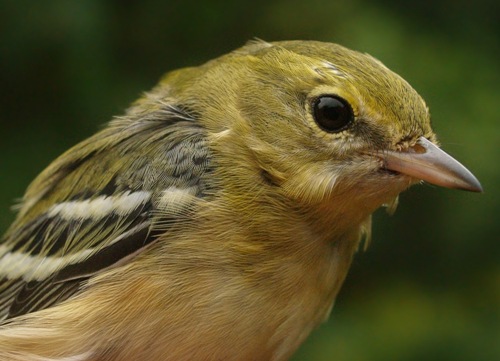
This is the time of year that the infamous "confusing fall warblers" start causing headaches for birders. In the hand there are some extra clues available, but even just a good view of these species is actually usually enough to identify them correctly. Above is a Bay-breasted Warbler, very different from how it looks during the breeding season, but recognizable in fall by its warm buffy underparts and greenish head, without much streaking.
(Photo by Simon Duval)
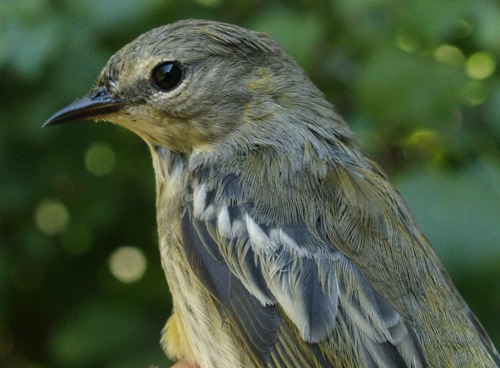
For comparison, here is a Cape May Warbler, more of a grayish-green overall, and with distinct streaking on the breast.
(Photo by
Simon Duval)
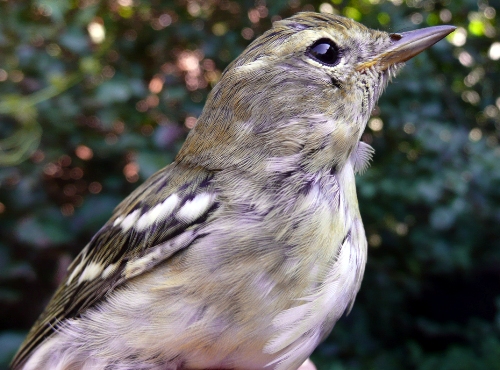
And to complete this trio, a Blackpoll Warbler, the palest of these species, but with the strongest facial pattern.
(Photos by
Simon Duval)
|






